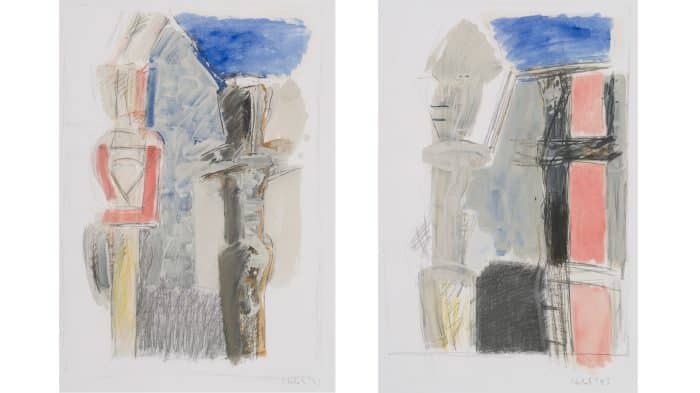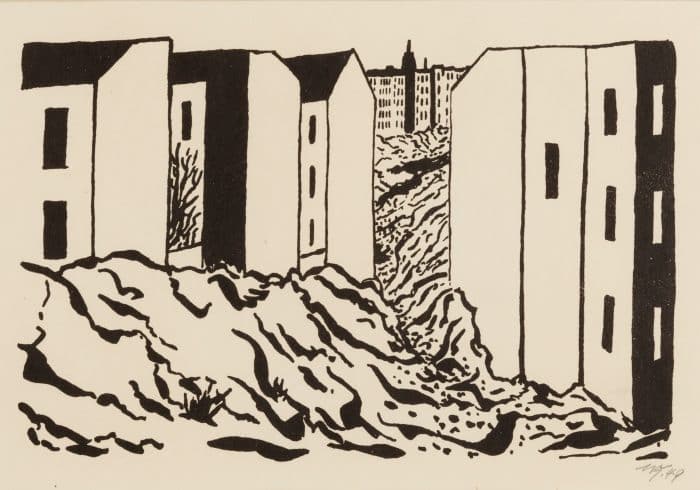“As you dream, so should you paint.”
(Werner Heldt)
Dreams, wistfulness, the hometown Berlin, and freedom are among the themes explored in the exhibition opening on 16 February 2024 at the Stiftung Kunstforum Berliner Volksbank. To mark the 70th anniversary of the death of Werner Heldt (1904 – 1954) – a German painter, printmaker and poet who was one the postwar period’s most influential artists – his works are shown in dialogue with earlier and current works by Burkhard Held (* 1953). Both artists are represented in the Kunstsammlung der Berliner Volksbank, and together, they have painted a century of history. The paintings, works on paper, and prints stem from various phases in both artists’ oeuvres, with atmospheric images emerging that enter into a dialogue in the midst of historical contexts.
Werner Heldt was born in 1904 in Berlin and studied at the School of Applied Arts from 1922 to 1924, creating his first artworks there. He then attended the Academy of Arts in Berlin-Charlottenburg. Impressions of the (nocturnal) city of Berlin became the focus of his quiet, observant approach. His life took a decisive turn in the years after 1929. During the National Socialist period, Heldt fled into exile to the island of Mallorca, where he grappled with the oppressive threat arising in his homeland. In 1936, the outbreak of the Spanish Civil War forced him to return to Berlin. In 1940, he entered the Second World War as a soldier, returning in 1946 from British captivity. He lived in Weissensee, in what would soon become East Berlin, until 1949, before moving to West Berlin. Heldt died in Ischia (Italy) in 1954.
Burkhard Held was born in 1953 in West Berlin. From 1972 to 1978, he studied at the University of Arts, West Berlin. From 1979 to 1980, he spent a year studying in Garrucha, Spain, on a scholarship of the Studienstiftung des Deutschen Volkes. From 1993 until his retirement, Held was a professor at the University of Arts in Berlin. He lives and works in Berlin.


The dreamlike rendering of the inner world is a characteristic feature of Werner Heldt’s art, with the notion of dream legitimising a particular experience of reality. The dream concept reappears in a longing for freedom in faraway places, while both Werner Heldt and Burkhard Held occupy themselves with the role of time in an image.
The latter artist concentrated during the 1980s and 1990s on the subjects of figure and space in particular. For him, the two were not separate entities; space in his paintings also encompasses the figure. Spanish architecture’s distinct, austere surfaces and adjoining edges certainly influenced his figurative paintings. In later works, the figure increasingly dissolves during the painting process. In Berlin, his hometown’s cityscape evoked a longing for nature and the vastness of a landscape. During his stay in Portugal beginning in 2018, Held’s eye opened to the changing conditions of the sea. The seascape compositions in his paintings gain in colour intensity and size. High-contrast, two-dimensional elements present themselves as abstractions of the figurative.
In the Berlin am Meer series of works, which Werner Heldt created in the 1940s, the artist, as if in a daydream, transformed his destroyed hometown of Berlin into a sea. The postwar works exhibit sharply drawn lines and enlarged spaces, clearly separating these features from one another. Elements of Mallorcan architecture can be discerned.
In Werner Heldt’s Stilleben am Fenster series, created during the 1940s and 1950s, and Burkhard Held’s Berliner Fenster (1988), his native Berlin is viewed from outside and inside. That which happens outside is registered, recorded and – regarding the inner world of feelings – expressed; the window view intensifies an underlying mood of yearning.
In their stylistic forms of expression, Werner Heldt and Burkhard Held also find a similar language embodied in an objective abstract expressiveness. The spatial constellations, shapes and objects arise from the expansion of space or through the penetration, stretching and shaping of planes and the liberation from boundaries.
Differing impulses towards Berlin create a sense of tension between the moods of the two artists’ images, resulting in an intriguing dialogue substantively and stylistically.